Food Trends Posts
How to Order Food for Large Groups

Nothing improves an office event like food. Whether you’re celebrating a birthday or just bringing everyone in for an all-hands, the right grub does a lot of heavy lifting. It lets colleagues know they’re valued, and it gives them time and space to nosh, chat, and just bond. Besides, food is awesome! Everyone loves a good meal.
(Especially clients. Clients are very impressed with food.)
The only real problem is putting together a meal for a large group of people who may have varying tastes and dietary requirements.
At Waiter, we’re all about food — and we love feeding large groups of people. That’s why we’ve put together this list of food for large groups. All of the options listed can be scaled up to feed whatever size group you end up hosting.
Speaking of hosting…you aren’t planning on doing any of the below alone, right? The planning and cooking hours behind the choices below are…intense. You can go right ahead, if that’s your jam, or arrange for an office potluck…or…you could let someone else do the catering work while you just kick back and eat.
Really, it’s up to you; the food will be delicious either way. But if the idea of purchasing 200 tortillas and the ingredients to fill them makes you a little nervous, think about letting us help.
Now, on with the meal!
1. Taco Bar
Taco bars are pretty much universally popular, so they deserve the #1 spot. Bring in the tortillas, the protein (chicken, beef, carne asada, and more), the veggies, the salsa…and of course the cheese.
Alternates: Got some dietary restrictions to work with? Cue up some vegan meat and cheese options!
2. Pastapalooza
Take the beloved concept behind the taco bar and swap in pasta. You can go with tried-and-true familiars like spaghetti, macaroni, and fettuccine, or branch out with gnocchi, tortellini, and orzo. You’ll also want plenty of sauces (marinara and Alfredo are only the beginning; have you thought about pesto?). And let’s not forget the add-ons like various meats and cheeses, or herbs like rosemary and basil.
Alternates: Most, if not all, of the food described has gluten-free and vegan versions available.
3. Baked Potato Extravaganza
This is still technically a bar, but we’re aiming for festiveness. Set out large potatoes with all the fixings: cheese, bacon, broccoli, chili, salsa, and any herbs and spices. Oh, let’s not forget butter.
Alternates: Vegan-friendly and dairy-free varieties of cheeses (and yes, even vegan bacon) are available.
4. Breakfast-for-Lunch (or Dinner) Buffet
While breakfast food is usually consumed in the earlier hours of the day, there’s no law stating you can’t have it for lunch or dinner or any other time of day. So go big! Bring in scrambled eggs and sourdough to make toast. Set up a pastry plate loaded with croissants and bear claws. Yogurt parfaits and fruit are always winners, as are pancake- and waffle-making stations.
Alternates: If you’ve got vegans, gluten-free folks, or other dietary needs, you can find all sorts of breakfast alternatives available.
5. Pizza Party
Pizzas are pretty much the go-to meal for big groups. Some pies have 12 or more slices to go around, and there are so many varieties to choose from! There’s vegan pizza, vegetarian pizza, meat-lover’s pizza…and that’s just scratching the surface. Bring in Chicago and New York-style pizzas and judge the crusts. Throw in Greek-style pizza, too. And don’t get us started on the toppings, which are endless.
Alternates: None needed. There’s a type of pizza for everyone.
6. Salad Station
Salads are sometimes viewed as side dishes, but a good salad can be a fine meal on its own. Bring in an assortment of greens to serve as the base (spinach, lettuce, kale, arugula, and more) and then go nuts with the toppings or proteins like chicken, shrimp, nuts, and vegetables. Don’t forget about dressing, which is, for some, the most important part; ranch, Italian, and more are out there.
Alternates: Set up a fruit station so folks can have a sweet alternative!
7. Sushi Soiree
Nigiri and sashimi and maki, oh my! There’s a sushi roll that fits pretty much every set of taste buds. Most sushi contains a base of rice and seaweed, accompanied by other fillings (or toppings, depending on the roll). Salmon and tuna are popular, as are the beloved California rolls, but that’s just scratching the sushi surface. Crab and tofu, along with other types of seafood and vegetables, may also make appearances.
But…sushi can be hard to serve buffet-style, and you may have to accommodate colleagues who are just not into seafood. This might be a good time to turn to Waiter’s Meals on Demand, which lets you choose a restaurant (like a Japanese place that has sushi and non-seafood options) and place a customized order. The folks who want sushi can get it; those who don’t can choose something else. Everyone eats!
8. Dessert Decadence
Sometimes you just want something sweet. Dessert-for-Lunch (or Dinner) can cover a lot of bases. Ice cream sundae bars are often a hit; just bring in several flavors of ice cream and enough toppings to give people a sugar buzz that will last into the next century. But you can also look into cupcakes, brownies, cookies, or cakes and pies.
Alternate: Once again, the fruit platter can save the day. There are also dairy-free, vegan ice creams out there, as well as sugar-free sweets!
How to Serve Big Meals for Groups Without Losing Your Mind
Getting the whole office together for a meal can be stressful. But look, you don’t have to do all of the above on your own. Waiter.com’s Catering Delivery gives you a direct line to restaurants that make exactly the kind of meals you’re looking for, and in the quantities you need when you’re ordering office food for many people. All you really need to do is tell us where to put the food and herd everyone over when it arrives (although to be fair, most people follow their noses and don’t need the help).
So go ahead: dream big. Let us bring you the perfect pies from a local pizza parlor, or the region’s best baked potato. Japanese, Mediterranean, Thai, Indian, Mexican, and other cuisines are all on offer, and we even deliver the food in recyclable containers. Who isn’t doing dishes after the party? You!
Seriously, though, check out our group food ordering. We’d love to keep your entire team fed.
Who Invented Group Food Ordering?
As recently as a few years ago, ordering lunch for the office usually involved bringing in a ton of pizza or the local BBQ joint. Sometimes the restaurant would deliver the food; in other cases, you had to pull someone (or several someones, depending on how much you ordered) away from their work so they could pick it up and then haul it back to the office. And did anyone on staff have dietary restrictions? Sometimes you could make special requests, sometimes you couldn’t.
Let’s not get into the poor soul who had to wander the workplace, taking everyone’s requests before compiling them into an order.
Fortunately, corporate meal delivery has come a long way… and the change started earlier than you think. Ordering meals for the office online became possible in 1995, when Waiter.com set up shop on the World Wide Web and introduced Silicon Valley to the joys of ordering without picking up a phone.
It’s been a long and interesting ride since then, and many competitors have come and gone. So grab a snack and get comfortable — we’re gonna turn back the (analog, of course) clocks to the end of the twentieth century.
Corporate Meal Delivery
In 1995, ordering takeout looked very different.
Yes, the internet was around, but in a far more limited capacity. “Getting online” tended to mean dial-up, usually through a portal that jammed up your phone or fax line while it was in use. If you wanted to get a meal for your office, you placed an order over the phone and then traipsed down to the restaurant to pick it up. The more technologically advanced places might let you order by email or, if they were really fancy, fax it in.
(We’re aware of how quaint this sounds.)
Waiter.com set out to change that. Founded by Craig Cohen and Michael Adelberg, the company — then called World Wide Waiter — aimed to link restaurants with offices. In a 1996 interview with Palo Alto Weekly, Cohen explained the difficulties he encountered trying to get sandwiches made the way he wanted. It would be easier, he thought, to take orders via a computer.
As Waiter.com was located in Silicon Valley at the very start of the dot-com boom, its founders saw the difficulties office administrators faced trying to bring meals into offices. They built the tech around Waiter.com specifically to allow businesses to order meals for their people. The idea was novel: go to one “web site” and access heaps of local restaurants.
Of course, they had to pitch restaurants on both the service and the internet itself — many didn’t even have websites. Waiter.com often hosted the first web presence for Bay Area restaurants.
In its early years, Waiter.com simply acted as an ordering portal, taking a small commission. Restaurants handled fulfillment. But the real innovation was the Shared Shopping Cart, allowing multiple users to collaborate on a single order. This was revolutionary for its time.
Other platforms emerged in response, some of which no longer exist. But nearly all of them borrowed features that Waiter.com pioneered — menu uploads, saved credit cards, and multi-meal ordering.
A New York Times article in 2000 described online food ordering as “very much an evolving technology.” Despite hiccups with competitors, Waiter.com worked “with hardly a glitch” and delivered lunch within 35 minutes.
Technology Ups the Game
The early 2000s were a breakthrough moment. Internet access became widespread, and restaurants joined the digital era. But the real game-changer came in 2007: the smartphone.
Now, users could order food from anywhere. With apps flooding the market, food delivery became more convenient than ever.
Workplace cafeterias started to feel outdated. Corporate catering became the new standard, offering diverse menus delivered straight to desks. Employees loved it, and employers saw boosts in morale and productivity.
By 2007, Waiter.com expanded to serve individuals, but they stayed focused on corporate tools — like scheduled deliveries days in advance.
Unlike gig-based competitors, Waiter.com employed full-time drivers. They used insulated catering bags and prioritized professionalism and food quality. Other platforms stuck with plastic bags and part-time drivers — often leading to cold or missing meals.
How the Pandemic & Remote Workforce Changed Food Delivery
The COVID-19 pandemic drastically impacted restaurants and food delivery. As remote work surged and dining out slowed, platforms like Waiter.com became essential to business continuity.
They implemented contactless delivery and strict protocols. And when employees returned to offices, food once again became a strong employee incentive. A good meal could make people want to come back to work — and stay.
Waiter.com, already optimized for large group orders, was ready. Their infrastructure was built for exactly this challenge, and they continued to thrive in regions like Silicon Valley.
The Future of Group Food Ordering Is Ongoing
Food delivery is still evolving. Many services now use AI and chatbots for customer support, making it difficult to reach a real person.
Waiter.com has taken the opposite approach. Their customer service team is US-based and reachable by phone or live chat — just like it was in 1995.
While flashy startups come and go, Waiter.com has remained focused on what it does best: feeding offices with great food and better service.
In 2000, co-founder Mike Adelberg said, “There’s going to be a day when this will be a big part of the restaurant takeout business.”
What can we say? He was right.
Sources
A Semi-brief History of the Workplace Cafeteria
A wise employer once said, “Feed them, and they will work.”
All right, maybe no one has made that exact statement just yet, but there is a direct correlation between food and productivity — people do need to eat if they want to do good work. At some point in the twentieth century, employers caught on to that idea and began building cafeterias in their workplaces. When this happened precisely is difficult to pin down, but the idea picked up steam when J.C. Hall of Hallmark noticed that his employees had only expensive local restaurants to eat at during their lunch breaks. In 1923, Hallmark opened its employee cafeteria.
It turned out employees liked having a place where they could eat on the company dime. Grabbing a meal at the company cafeteria didn’t just save them money, either; taking breakfast, lunch, or occasionally dinner in the cafeteria saved them the time they would have spent cooking at home. Employers liked it, too, in part because it kept employees in the building.
Other companies followed Hallmark’s lead, adding cafeterias to their buildings. What wasn’t to love? They kept employees fed, happy, and on the property. The trend likely hit its peak in the mid-2000s, when big tech companies turned their workplace cafeterias into luxury experiences complete with themed menus, banana cheesecakes, and sushi chefs.
Changing Workplace Dining Trends
We can’t talk about the way the workplace cafeteria has changed without bringing up the COVID-19 pandemic and roughly half the country abruptly switching to remote work. Maintaining a cooking staff and a fully-stocked kitchen and eating area has always been expensive, but huge chunks of staff either not coming into the office at all or only visiting sporadically quickly turned many cafeterias into, well, money pits.
As of 2025, a good chunk of the workforce has returned to the office, but many are still remote and still others are working a hybrid schedule — maybe two or three days in the office instead of an entire week. Keeping a cafeteria open five days a week, eight hours a day for reduced and shifting workforce numbers quickly became a matter of diminishing returns. On top of that, many businesses have downsized their facility footprint by moving to smaller buildings. This reduced overhead, but also led to less space to operate a full-scale cafeteria.
In truth, a massive shift in how workplace dining works has been on the horizon for a long time. As early as 2007, experts were raising doubts about the company cafeteria, pointing to increasing costs. Automation and computerized menu services may have reduced the need for service staff, but someone still needed to cook and serve the food, as well as clean up afterward.
Meals as an Employee Benefit
Realistically, even before the pandemic very few businesses could afford the kind of cafeteria scale the tech companies provide, and as the cost of living increases, so too will the costs of running any kind of food service. (It’s no wonder employees really like meal perks: research indicates that employee satisfaction jumps when free food is involved.)
So it makes sense to roll at least some employee meals into a company benefits package. Not having to cook and pack a meal (or spend their breaks scouting for an affordable restaurant) can be a huge weight removed from employees’ shoulders, to say nothing of the money they’ll end up saving. Besides, happy employees are more productive employees.
The message is clear: food is clearly still a draw for potential and current employees, and wise employers will find new ways to provide meals as benefits. So, how can corporations design employee meal programs that keep everyone happy amidst all this reduced space and shifting schedules?
The Increasing Value of Office Catering
Restaurant delivery services have long been a staple of modern life; you open an app, click the meal you want, and it’s delivered to you — usually within the hour. Eating in had never been so delicious.
Scaling that service to meet the needs of a business captures much of that convenience (and tastiness) for office workers. It allows businesses to offer meals as a perk without the massive associated costs and space of a cafeteria; beyond that, the variety available far eclipses what a few on-staff cooks could whip up on a daily basis. Setting up and cleaning up tend to be easier, too.
While it’s an intriguing solution, office catering presents some challenges. Office administrators ordering for groups will need to know their colleagues’ dietary restrictions and preferences; they’ll also have to know who is in the office, who is working from home, and who is fully remote (and how to look after them, too) every single day. Beyond that, there are budgets to consider; bringing food in may be less costly than running a cafeteria, but it is usually not cheap.
The New Office Cafeteria: A Gathering Place
The order is placed, the food has arrived, and the office smells wonderful… but where, exactly, are employees meant to chow down?
As we mentioned earlier, the post-pandemic downsizing has led to smaller workplace cafeterias. Happily, many companies have maintained at least a kitchen and a separate break area where staff can kick back and relax — and not eat at their desks.
Maintaining some sort of place for employees to eat makes sense from a productivity angle, as workers who take lunch breaks tend to be more engaged than those who don’t. Getting away from immediate work can serve as a mental and emotional reset, giving employees an energy boost and new clarity before they get back to the job.
These break areas often end up serving multiple uses in a busy workplace. They can be commandeered for meetings if extra space is needed, but can also host events like company happy hours, trivia sessions, or ice cream socials. Some businesses have looked toward more colorful solutions, turning their cafeteria spaces into showcases for local artists — some may even show off employee artwork!
Beyond that, having a space for employees to just hang out and chat with their coworkers can have an incredible impact on overall morale. Many of us spend upwards of 40 hours a week with our colleagues; building camaraderie and trust with them often leads to better collaboration and contributes heavily to job satisfaction and worker retention.
Cafeterias Pose New Challenges in the Hybrid Workforce
While they provide a place to sit and eat, most workplace cafeterias are somewhat limited in what they can offer employees. They’re producing vast quantities of food for large groups of people, which generally means their menu options are limited and may even be repetitive — for example, a set selection of meals for every day of the week.
Cafeteria chefs may not always be able to take dietary limitations into consideration, meaning some employees may need to look elsewhere for meals. The costs of running a cafeteria — as we discussed above — often mean keeping it open for limited hours that don’t always align with employee needs. Hybrid employees or those on flexible schedules may not be able to take lunch (or even be at the office) when the cafeteria is open.
It’s hardly fair to just deny them food when their other colleagues are benefiting from the cafeteria. In some cases, businesses have turned to catering to fill the gaps a typical cafeteria might leave. Hybrid employees and those with dietary specifications can benefit from this kind of supplementation: they still get the perk of eating on company dime (and time) even if the company cafeteria isn’t open while they’re working or otherwise meeting their needs.
The Future of the Cafeteria
While the size, appearance, and services the workplace cafeteria offers may shift with the times, it’s likely not about to disappear completely. You can still find the large, full-service company cafeterias, but they might offer limited operations — open every three days, for example, and only for a couple of hours at a time.
The current office cafeteria is often more of a gathering place, referred to as “the kitchen” (even if there’s not a fridge) or “the break room.” Workers still hang out and eat their meals there, even if those meals aren’t made on the premises. It’s still a solid contributor to office morale and productivity and will likely continue to do that long into the future.
Additional Sources
Perfect Paella: Bring Some Spanish Flavor into Your Workday
Paella is a delicious rice, vegetable and meat dish that originated in Valencia, Spain, during the days that the Moorish Kings were in power. According to legend, it’s a dish that melds two different old cultures: the Romans – who made the special pan within which paella is cooked, and the Arabs – who brought flavorful rice to the table. After royal banquets, servants would mix leftovers in large pots to take home, constituting early versions of this now-famous dish. The recipe was eventually refined and spread throughout the entire country, which created a huge explosion of paella dishes that include a variety of meats, veggies, and flavors that we call get to enjoy today!
There are two reasons why paella makes a great lunchtime meal delivery option for you: first, it’s a naturally balanced meal between the rice, meat, and vegetables that are mixed into the dish. A well-balanced lunch means you’ll get the right combination of food groups to feel full and sated, and be better able to sustain your productivity throughout the rest of your day. Second, the flavor is amazing – and since there are so many different options for how this particular meal can be made, you’ll never feel like you’re getting the same humdrum meal two weeks in a row. Intrigued? Let us tempt your tastebuds – here are three of our favorite Spanish paella dishes you could order in for your office meals today!
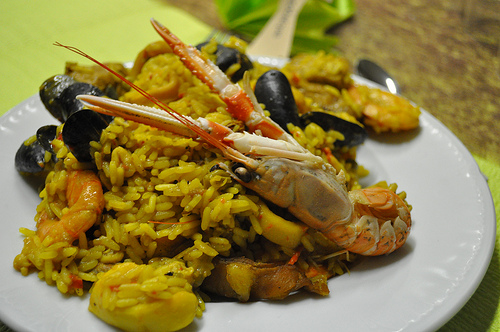
Photo Source: Flickr user fred_v
Traditional Paella
As it’s been made for centuries, traditional paella includes a few types of seafood, usually shrimp and mussels, in combination with one or two ‘land meats,’ like chicken and spicy sausage. While they’re not flavors you would usually think of mixing, there’s something totally perfect about how these proteins blend with the rice and veggies in this meal. Finely chopped veggies are then added to the dish, usually in the form of red bell peppers, diced tomatoes, and peas. Then some of the beautiful flavors of Spain, saffron and paprika, are mixed into the dish. Because paella is cooked in one big pan, the flavors infuse the entire meal with something unique and totally tasty. We definitely recommend adding this dish to your list of lunch delivery items to try this week!
Grilled Paella
This yummy dish infuses a smoky flavor with some of the traditional flavors of Spain. Shrimp, chicken, clams, and Spanish chorizo bring a yummy combination of meats (and protein, for energy) into the dish. Mixed with traditional Spanish paella rice, chopped tomatoes, and onions, the main ingredients of this lunch meld together perfectly. Seasoned with saffron, a traditional way to take the flavors of a paella dish up a notch, this plate is then topped with a little squeezed lemon – which adds something modern into the mix. When you’re craving barbecue, but are ready to try something different than a burger or chicken sandwich, this is a more refined meal choice to order for office delivery today!
Mushroom Paella
When it comes to eating paella in the winter months, sometimes swapping a few ingredients can do just the trick. In the case of this dish, using mushrooms to compliment the traditional red peppers used in the original version is the perfect way to bring a little heavier taste – and texture – to the meal. Mushrooms are definitely a strong feature; the mixture of flavors from the shiitake and oyster varietals in bulk really pack more mass into your meal. Not only that, but mushrooms are an excellent way to help your body digest food and boost your immune system – taking this dish up a notch to terms of the health benefits it provides. This midday meal also mixes in chicken and shrimp, as well as some Italian parsley and cloves to change up the flavor a bit. It’s one of our favorite takes on a very old favorite dish!
Lunchtime Flavor Swaps
When it comes to changing up the flavor of your favorite lunchtime meals, paella is definitely a tasty treat that you should considering ordering for delivery today. The seaside taste mixed with the flavorful spices of Spain will leave you ready to book a trip to walk the streets of Valencia. You might even be intrigued to make a batch of fresh sangria over the weekend!
When you’re ready to try some of the unique flavors Spanish paella has to offer, Waiter.com is here to help. Our easy to use meal delivery service allows you to order from your favorite restaurants around the city, and have your food delivered straight to your office. Planning a bigger affair? Our corporate catering can make a yummy paella dish your team is sure to love for any big event. Learn more about how we can help you make your next big meeting one to remember!
Office Snacks: 4 Smart Swaps to Make for a Healthy Vending Machine Today
There’s a trend within the corporate office space to bring healthier options into every employee’s workday. And while offering exercise classes, healthy living seminars, and yummy food delivery options are all great ideas, there’s still one big offender at many offices around the country: the traditional vending machine. The often used, but little thought of snack dispenser is the office hot spot for anyone craving an easy morning snack or a mid-afternoon chocolatey treat. The problem is that most of the items offered by a traditional vending machine are filled with fat, empty calories, and little protein. This won’t help keep your staff full for the long haul and doesn’t provide any of the brain boosting nutrients that healthier foods offer.
And when it comes to stocking your vending machine with the right foods, you should feel great about being health conscious for the benefit of your employees. Incorporating more whole grains, fruits, veggies, legumes, and dairy into your diet can help you do more than just help you to stay fuller, longer – the combination of vitamins, protein, and antioxidants can help your staff be more energized, more productive, and happier overall. So if you’re looking to make some changes to what your vending machine has to offer, we’re right behind you – with four of the major swaps you can make for a healthy vending machine today.
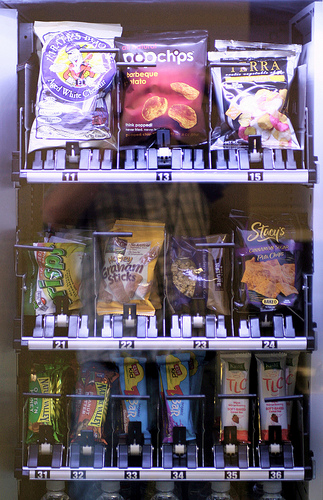
Photo Credit: Flickr user cliff1066
Swap soda for sparkling water: While it’s true that a little sugar or caffeine boost can help you get through the next hour of work, it’s not going to keep you going for the entire afternoon. And with nearly two-thirds of the American population not drinking enough water during the day, promoting healthy drinks, like sparkling water or low-calorie flavored waters, can encourage your team to contribute more to their daily intake. Getting enough water is essential for preventing headaches and dehydration, so it’s an easy way for your team to get a little healthier, one sip at a time.
Swap cookies for protein bars: The truth is, there are times when everyone needs a quick bite between meetings, especially when they don’t have time for lunch. And usually in these situations, a vending machine would give your staff the option of cookies or chips. Swapping out those cookies for protein bars can be a great way to fill your team up while still providing a lot of protein, giving them the energy and brain-boosting power they need to power through their next meeting, when they can finally order some lunch. This can help your employees – and the quality of their work – be much better for the wear.
Swap potato chips for lighter snacks: While they can be a tasty treat every once in a while, chips can be packed with empty calories – which give you nothing in terms of nutrition to get through the rest of your day. Swapping out these snacks for healthy option like light popcorn, a small serving of trail mix, or carrots and hummus – options that are filled with whole grains, fiber, protein, and essential nutrients – can be a great way to give your staff the boost they need to fuel up before a big conference call.
Swap juice for milk and yogurt: Not only can three servings of dairy per day help you control your waistline, they’re packed with nutrients like calcium for bone strength and are a good source of protein, which can both satiate hunger and help you feel more energized. Lowfat milk actually has the right balance of protein and carbs to be the perfect post-workout re-fueling drink – which can make it an even better addition to your healthy vending machine if you’re offering workout classes over the lunch hour. And with lots of high-protein Greek yogurt on the market these days, it’s easy to find options that your staff will love – maybe even more than a bag of gummy bears!
Helping your staff get healthy
Leading a healthy lifestyle isn’t something that happens overnight. But it can be a lot easier to make the conversion when you’re surrounded by nutritious options, including when you’re at work. So stocking your vending machine with healthier snacks can be a great way to support your staff in their efforts to incorporate wiser choices into their daily eating habits – as well as give them some healthy snack options when running to meetings between meals.
And when it comes to healthy meal delivery, you can even do more to bring healthy options to your team’s plate each day through Waiter.com’s custom cafe. We give you access to healthy menu choices from up to six local restaurants every day. And our easy-to-use flexible payment options let you allocate the tab to the company or your staff. Now that’s a way to really help your team understand the value of healthy eating!
The 6 Tastiest Food Delivery Dishes for National Chicken Month
Sure, chicken is pretty ubiquitous when it comes to our meals in this country. In fact, it’s recently surpassed even beef in popularity among meat-eaters, with Americans on average consuming about 60 pounds per year. But that doesn’t mean that chicken has to be boring or served every single day.
September is National Chicken Month, and there’s no better time to expand your chicken horizons than during this tasty celebration of all things poultry. Use this month to discover new mouth-watering chicken dishes or reacquaint yourself with old favorites, whether you’re planning catered office lunches for work meetings, catering training sessions, or providing food delivery meals for your staff during late-night, busy office projects. You can liven up the work place by choosing exotic and special chicken dishes, or go comfort food style with time-tested, all-American classics!
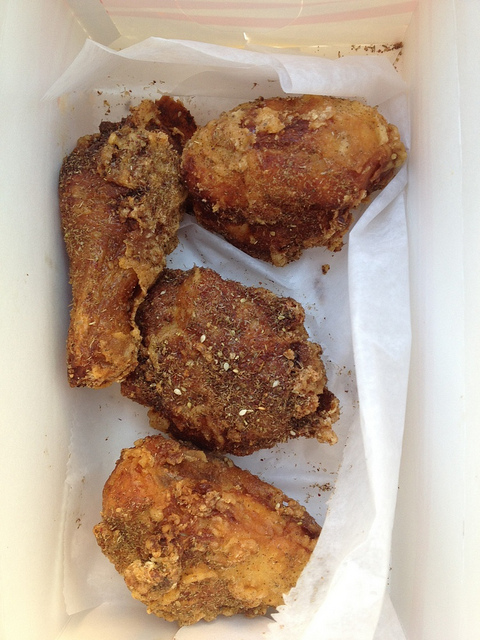
Image source: Flickr user goodiesfirst
In addition, chicken doesn’t just taste great – it has a lot of wonderful health benefits to add to the mix. It’s lean and high in protein, a good source of the mineral selenium, and it’s packed with important B vitamins. Offering your employees healthy and delicious chicken food delivery options for lunch can help boost energy, productivity, and liven up the workplace.
1. Chicken Curry Chicken curries come in all kinds of variations, including yellow curries, green curries, red curries, Thai curries (typically coconut milk-based), Indian curries (most of the time, yogurt-based)… well, you get the idea. No matter the specific chicken curry that you choose for a lunch or overtime meal, your employees will thank you!
2. Coq au Vin This is a classic French dish, consisting of chicken thighs, breasts, and legs cooked in red wine with root vegetables and simmered for hours until it’s rich and tender. Traditionally, coq au vin was made with a tough rooster (the long cooking time in wine served to tenderize the meat), but today, any chicken will do – including farm-raised, all natural, organic birds.
3. Fried Chicken The star of picnic lunches everywhere, nothing says comfort like a plate of fried chicken! With a leafy green salad and some baked beans on the side, it’s a lunchtime splurge that’s a special treat. It’s also the perfect choice for an outdoor meal on a crisp, fall afternoon — the perfect break to a busy work day. Just set up the picnic tables and let everyone enjoy a festive outdoor meal.
4. Chicken Chili Ditch the beef or pork chili this month and give chicken chili a try! Often referred to as white chili, this hearty stew uses a mix of white beans, broth, green chiles, and shredded chicken for a spicy, out-of-the-ordinary lunch. Fragrant and filling, a bowl of this spicy stew is guaranteed to perk up the troops.
5. Chicken Salads & Wraps Chicken salad is a familiar option, but how about a chicken salad with grapes and cashews? Or a curried chicken salad with yogurt instead of mayonnaise? Or, forget about the creaminess altogether and order a chicken and pasta salad with a zippy olive oil vinaigrette. And as an alternative to sandwiches, wraps are a delectable option. With layered chicken, vegetables, and maybe even some hummus, you’ll have a great-tasting and nutritious lunch spread for the whole company.
6. Chicken Mole A classic Mexican dish, chicken mole is a long-simmered, signature speciality made with peppers, spices, nuts, and sometimes even chocolate. Like curries, there are many variations and it’s an easy way to satisfy your whole group with a robust bowl of tender chicken in a spicy, flavorful, and unique sauce.
There are so many chicken options to explore for your office meals this month, with Waiter.com offering all the menus and meal options you could want for your office and staff. Celebrate delicious, versatile chicken throughout the month of September with curries, wraps, ethnic specialities – the food delivery possibilities with this well-loved ingredient are practically endless!
7 Fall Flavors Ready to Liven Up Your Office Lunches This Autumn
When you’re considering office lunches this fall, don’t forget to keep an eye towards eating seasonally! This food trend is one that finally just makes sense (unlike the cronut, perhaps): fruits and vegetables taste best during the time of year that they’re naturally at their peak of flavor. And autumn, waiting just around the corner, is all about hearty vegetables, robust flavors, and healthy, bountiful choices.
While summer foods suggest bright and flavorful stone fruits and light, bright tastes, the brisk autumn months translate into beta-carotene-packed slow-cooked vegetables, leafy greens, and warm, exotic spice blends featuring ginger, turmeric, fennel seeds, and spicy chile peppers. September through the beginning of December, the list of seasonal foods and fall flavors is almost as long as the warmer months’ offerings. And with many restaurants offering choices that feature nutrient-packed autumn superfoods that taste just as amazing as they look, you’ll have no problem livening up your office lunches!

Image source: Flickr user valkyrieh116
1. Warm spices
On a chilly afternoon, a big bowl of Indian curry, a gingery stir-fry, or even a Moroccan tagine all offer a comforting and flavor-packed break from your hectic day. A spice like turmeric, which is full of curcumin (a powerful anti-inflammatory and antioxidant that gives curry its bright yellow flavor), as well as ginger, cardamom, and chiles can make a simple bowl of vegetables and rice sing with tummy-warming goodness.
2. Butternut squash and pumpkin
True stars of the season, these fleshy orange squashes deliver a one-two punch of dietary fiber and vitamin B6. At the start of the cooler months, look for take-out menu items like pizzas, spicy curries, and even sandwiches featuring roasted squash – and even specials like pumpkin hummus and butternut squash soup.
3. Brussels sprouts
Many take-out choices include a special seasonal section where you might find roasted Brussels sprouts on salads – and even artisan pizzas! This autumn vegetable is loaded with vitamin K, vitamin C, folate, and potassium — and unlike the steamed, sad brussels sprouts that parents have been forcing on their kids for ages, today’s Brussels sprout is usually served roasted and golden, braised with bacon, or even shredded and tossed with a crisp, flavorful vinaigrette for an unusual autumn salad!
4. Apples and pears
Since they’re readily available year-round, it’s sometimes hard to remember that apples are really an autumn crop, but with pears, it’s easier to think of them as a special fall treat. And while you can certainly enjoy apples in spring, summer and winter, there’s something about a crisp, fall apple that really speaks to the season. Both apples and pears add crunch in salads, sweetness in baked goods, and are amazing when featured in savory dishes.
5. Arugula
This peppery, leafy, cool-weather green is almost as ubiquitous as the apple these days, and offers a healthy dose of phytochemicals and minerals like iron and copper. Add some of these vitamin K-packed greens to your pizza order, swap it for lettuce in salads, or even tucked into a roasted veggie sandwich.
6. Cabbage
Starting in the cool fall months, cabbage is a go-to source for vitamin C, fiber, and beta-carotene. You’ll find varieties like green, red, and Savoy in delicious take-out choices like Chinese stir-fries, coleslaw, salads, fish tacos, and Thai spring rolls.
7. Sweet potatoes
Nothing says fall like roasted sweet potatoes. Much like squash and pumpkin, this star of the Thanksgiving table is also easily found on seasonal menus throughout the cold, crisp fall months. Look for curries, salads, and special sides that feature these vitamin B6 and vitamin D-loaded tubers. And yes, even sweet potato fries seem extra delicious this time of year!
All seven of these in-season flavors offer a great way to encourage healthy eating, along with the best tastes of the coming cool months. And you’ll easily find them at Waiter.com, with a large variety of options that will keep you eating vibrant, delicious office lunches no matter what time of year!
Boneless, Skinless, Boring: Better Proteins for Healthy Lunch Catering
If you’ve been trying to eat healthy at the office, you probably have go-to dishes that you can order from a local restaurant or find at the office lunch catering table: a green salad with grilled chicken. A turkey sandwich — hold the mayo — on whole-wheat bread. A boneless, skinless chicken breast with a side of steamed vegetables. Bored yet? Here’s one solution: just say no to boneless, skinless poultry.
Don’t misunderstand: lean protein is important to maintaining a healthy diet (lean meaning sources of protein that are low in saturated fat, unlike the juiciest cuts of steak). Protein is essential to staying healthy, and the daily recommendations for the average adult woman are 46 grams daily, with 56 for men — although some nutritionists argue those numbers are significantly lower than what many active people should be eating.
But when it comes to lean protein, we believe that variety is just as important as quantity; without it, you might experience healthy-eating burnout and be tempted to revert to old office habits of pizza, burgers, and burritos. So if your healthy office lunches are stuck in a boneless, skinless poultry rut, it’s time to get inspired! There are so many more fish in the sea. Literally, in some cases.
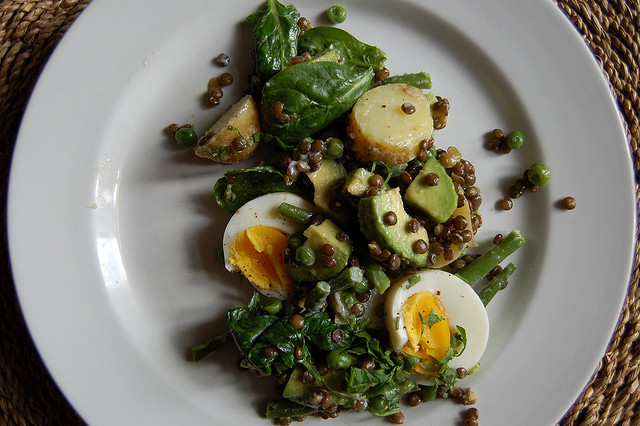
Image source: Flickr user zemlinki
Here are some poultry-free options, so you can suggest new fare for the lunch catering table — or just pick a different protein from your favorite takeout spot:
1) Salmon
There’s a reason this fish makes the list on many of our healthy eating posts: it’s low in saturated fat, high in proteins and B-vitamins, and utterly delicious. Request it cooked in olive oil instead of butter to ensure you’re getting quality unsaturated fats and plenty of omega-3’s.
Per 3-ounce serving of cooked Coho salmon: 21 grams protein, 151 calories, 1.7 grams saturated fat
2) Greek yogurt
While primarily thought of as a breakfast staple, Greek yogurt is an incredible protein source — and can double as a base for sauces or even as a dessert when topped with fresh berries. At any meal, nonfat Greek yogurt deserves a spot on the table!
Per 6-ounce container of nonfat Greek yogurt: 17 grams protein, 100 calories, .2 grams saturated fat
3) Lentils One of the best vegetarian protein sources, lentils are also one of the highest non-meat sources of iron. A warm lentil salad is a hearty substitution for the usual leafy greens, and if you like Indian food, then you’re practically guaranteed to find a delicious — and healthy — Indian lentil dish on the takeout menu.
Per cup of boiled lentils: 18 grams protein, 230 calories, .1 gram saturated fat
4) Scallops
Scallops get a bad rap, nutritionally speaking, because they’re often drowned in butter during cooking. When prepared in a healthier manner, though, scallops are actually one of the leanest proteins out there. If your favorite Thai restaurant offers scallops as a protein choice in curries, give them a try: they’re usually simmered in the curry sauce, so no additional fat is involved in the cooking process.
Per 3-ounce serving, steamed: 17 grams protein, 95 calories, .2 grams saturated fat
5) Eggs & almonds & cottage cheese
Remember, not all protein has to be a big hunk of fish or meat — by combining a few foods with moderate amounts of protein, you can end up with a very well-rounded lunch. For instance, instead of topping your next salad with a grilled chicken breast, order your leafy greens with a hard-boiled or poached egg and healthy serving of almonds for a delicious change of pace — and add a side of cottage cheese to boot!
Per poached egg: 6 grams protein, 71 calories, 1.6 grams saturated fat Per 1 ounce serving of almonds: 6 grams protein, 163 calories, 1.1 grams saturated fat Per 4 ounces of low-fat (1%) cottage cheese: 14 grams protein, 82 calories, .7 grams saturated fat
6) Quinoa
You can’t have a list of lean proteins without including quinoa! This hearty grain even has the rare distinction of being a vegetarian “complete protein,” meaning it contains all nine of the essential amino acids we need to take in through food (most other complete proteins are animal-based). Plus, it’s so easy to incorporate into salads — try a zesty black bean, corn, tomato, and quinoa salad for a refreshing yet hearty summer dish on the catering table (perhaps alongside a few scallops or piece of salmon?).
Per cup of cooked quinoa: 8 grams protein, 223 calories, .4 grams saturated fat
And the easiest way to add variety to your office’s lunch catering program? Enlist support from Waiter.com! We offer a wide range of menus to choose from, and our Virtual Cafeteria Service makes providing healthy meals for every taste in the office downright stress-free.
– All nutrition info above according to Google’s nutrition tool –
Eating Insects, Ingesting Nanobots: The Future of Food Trends Just May Change the World
The office is a veritable breeding ground for quirky food trends: your in-the-know coworker wants to go wait in line for ramen-noodle burgers at lunch, while your organic-foods-crazed boss insists on ordering the latest artisan pizza toppings. It can be eye-opening or maybe even a little annoying… but, these kinds of food trends aren’t exactly changing the way we eat or how we live.
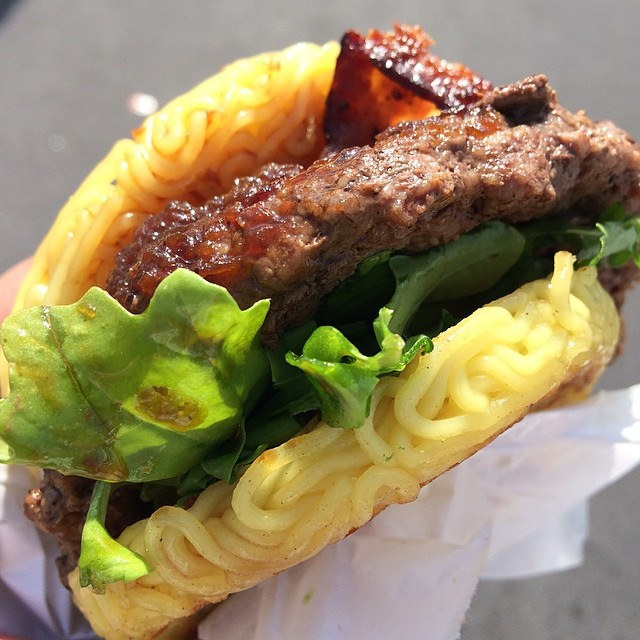
Image source: Flickr user Arnold Gatilao
On a more serious end of the food trend spectrum, though, some potentially revolutionary ideas may do just that. From futuristic technological innovations to a potential shift in how we define the concept of “edible,” these latest innovations just may change the world. Get ahead of the office foodies by learning about these truly important culinary trends (no offense, cronuts):
Insects for dinner
Imagine a food packed with protein, calcium, omega-3 fatty acids, and B vitamins. It’s incredibly efficient to raise — potentially twelve times more than cattle — and very affordable. So put down the flyswatter and pick up your fork: it’s time to start eating bugs. That’s right; entomophagy, or eating insects, is gaining considerable traction in the forward-thinking food world. Bugs have long been eaten around the world, and are finally beginning to pop up on restaurant menus in the U.S. And, according to their proponents, bugs can taste really good. As author Daniella Martin describes in Slate: “Crickets, for instance, taste like nutty shrimp, whereas most larvae I’ve tried have a nutty mushroom flavor. My two favorites, wax moth caterpillars (aka wax worms) and bee larvae, taste like enoki-pine nut and bacon-chanterelle, respectively.” Now the only question is… are crickets eligible for Meatless Monday menus?
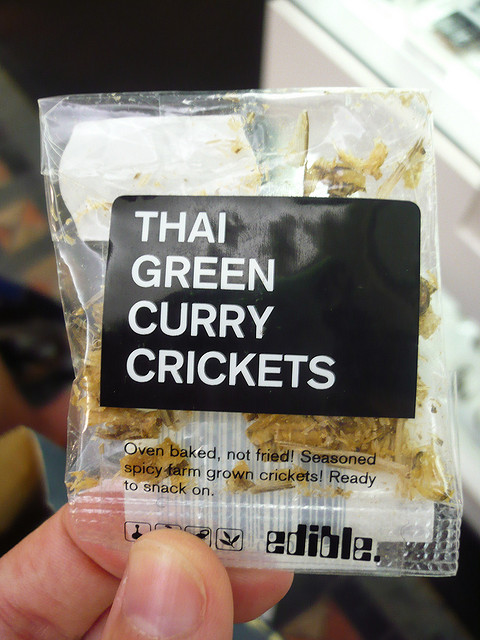
Image source: Flickr user Sarah
Ingestible nanobots
Not exactly food, not quite medicine… ingestible nanobots are literally tiny computers that you eat. While this “trend” may sound more like science fiction than ramen-noodle burgers, the pill-like microcomputers are already being heavily funded and tested in the UK. It works like this: after you swallow the pill-like computers, the nanobots function like sensors and transmitters, measuring your internal biorhythms (heart rate, bone density, vitamin levels, etc.) and reporting that information back to you – or your doctor. While privacy is an obvious concern, some proponents liken ingestible nanobots to the next logical step along the path being laid by Google Glass and even fitness wristbands. If knowledge is power, ingestible nanobots have the potential to transform how we think about taking care of ourselves.

Image source: Flickr user Nomadic Lass
Edible packaging
There’s no denying that we’re hooked on fast food, partly due to its oh-so-irresistible combination of salt and fat, and partly because it’s so darn convenient. WikiCell, the brainchild of a Harvard bioengineer, wants to capitalize on our preference for all things portable, while helping the environment at the same time. WikiCells are edible and/or biodegradable packaging for food: think the skin of a grape, only chocolate-flavored and wrapped around coffee or ice cream. In most cases, you eat the packaging right along with the food. In a few other instances, WikiCell products will function like an orange skin: you don’t eat it, but it’s fully biodegradable, and creates no excess waste. The membranes of Wikicell products are made from a combination of natural food particles and binding carbohydrates, creating a protective — yet edible — membrane. While most of the current WikiCell offerings are small and grape-like in size, in a WikiCell future, the sandwich you pick up from the deli won’t be wrapped in paper, but in another part of your sandwich.
These food trends may have the potential to change the world, but at Waiter.com, we just want to change the way your food gets to you! We offer plentiful menus, easy online ordering, and fast delivery — along with our innovative Virtual Cafeteria Service, making it a breeze to feed an office full of hungry employees on a regular, reliable basis. Now that’s a trend any workplace can get behind!
Researchers Discover Secret of Mediterranean Diet: Make Nitro Fatty Acids Part of Your Office Meals!
Followers of food news and health-conscious diners who are looking for healthier office meals have heard it all before: the Mediterranean diet is almost too good to be true. Research has suggested that following a Mediterranean-style diet can help reduce the risk of chronic diseases, improve memory, and even prevent depression. That’s why Mediterranean-inspired office meals are one of the healthiest cuisines that wellness-focused workplaces can serve.

Image source: Flickr user netsnake
And by and large, it makes sense. The diet is rich in vegetables, legumes, fruits, and fish, and low in red meat and processed carbohydrates. One question that has plagued researchers may finally have its answer, though. The Mediterranean diet isn’t necessarily low-fat — olive oil and nuts are staples — yet following it seems to prevent heart disease and lower blood pressure. How is that possible?
The answer, as always, is to eat your vegetables. A new study on the Mediterranean diet in mice, published May 19th in the Proceedings of the National Academy of Sciences, has found that it’s the combination of certain vegetables and olive oil that’s responsible for the Mediterranean diet’s heart-healthiness.
It works like this: pairing olive oil with some vegetables leads to a reaction between the unsaturated fats in the olive oil and certain nitrites and nitrates found in many vegetables, including spinach, celery, and carrots. The fats and the nitrites/nitrates combine to create awesomely-named compounds: “nitro fatty acids”. Nitro fatty acids, in turn, seem to improve heart health by relaxing our blood vessels and lowering blood pressure.
The researchers determined this by selectively feeding mice with high blood pressure a diet with lots of the unsaturated fats and nitrogen compounds found in olive oil and veggies. After five days, the mice had lower blood pressure — except for a small group that had been specifically bred to be resistant to nitro fatty acids. Of course, further research is needed to see if the same results appear in humans, but it’s a really promising — and sensible — explanation for why a relatively high-fat diet like the Mediterranean can lead to better heart health.
So how can you make this equation work to unleash the power of nitro fatty acids during your office meals? Luckily, we have a few suggestions!
1) Swap your salad dressing. Instead of ranch or bleu cheese atop your spinach salad, go for a balsamic vinaigrette made with olive oil for your nitro fatty acid fix!
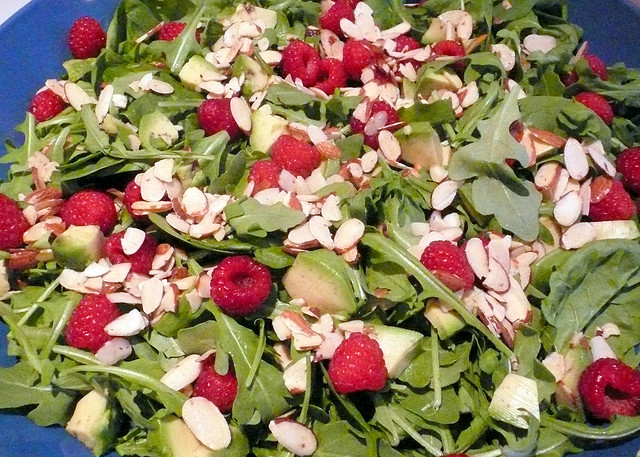
Image source: Flickr user atl10trader
2) When you order a deli sandwich, skip the honey mustard in favor of oil and vinegar, and add spinach instead of lettuce for a nutrient boost.
3) Choose heart-healthy snacks. Find hummus made with olive oil instead of the less-healthy canola oil, and serve it with baby carrots and celery.
4) Since avocados have the same unsaturated fats as olive oil, the study’s authors suggest they will have the same effect in olive oil’s place. At your next meeting, serve guacamole and radish slices for a crisp and refreshing alternative to chips and dip.
5) The same rule goes for nuts, so go nuts! Add them to your spinach salad for a heart-healthy crunch.
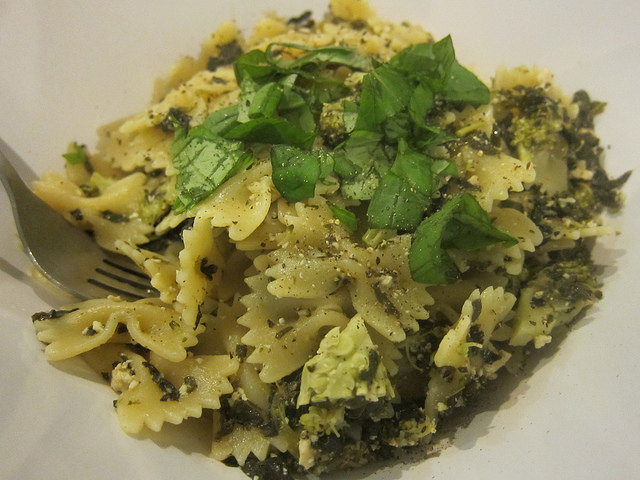
Image source: Flickr user Sharon
6) Have a pasta makeover. Next time you order Italian take-out or have a catered meal, choose a pasta with sautéed veggies and pesto (usually made with olive oil AND nuts) instead of a creamy tomato sauce.
Serving Mediterranean-inspired office meals is a no-brainer: healthier employees are happier and more productive. And with plentiful menus and prompt delivery, Waiter.com makes it as easy to provide delicious, wholesome, nitro fatty acid-powered meals to your team!
Time for a Food Delivery Makeover: The 7 Tastiest Artisan Toppings for Gourmet Pizza
Is there anything more satisfying than a good slice of pizza? Gooey cheese stretching from slice to pie as you lift it away to your plate, a few scattered slices of pepperoni, and maybe a light sprinkling of red pepper flakes on top… perfection. There’s a reason this comfort food is a food delivery staple at the office, especially when employees are working late nights.
But sometimes we can get burnt out on pizza, and the old favorite becomes totally expected. Inject some creativity into your next pizza order by taking advantage of the latest food trend: artisan pizza.
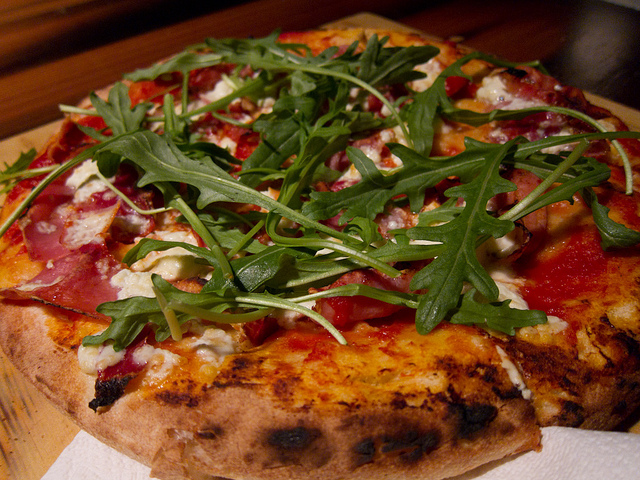
Image source: Flickr user Charles Haynes
That’s right — pizza is getting a gourmet makeover. From fresher ingredients to artisan cheeses to gourmet toppings, pizza restaurants focusing on handcrafted, high-quality pies are opening to great success across the country. Some create individual pizzas to order along their counters, Chipotle-style, while others are concocting menus of elaborate pizzas with unusual — yet delicious — ingredients.
Just a warning: your health-conscious coworkers may love the trend, but the plain-cheese crowd may not. At a recent pizza party at my office, my boss opened a delivery box, wrinkled his nose, and said, “When did they start putting salad on pizzas?”
It wasn’t salad, exactly — it was arugula, just a handful, scattered across the top of a thin-crust pie… and it’s the perfect place to start with our introduction to some of the tastiest artisan toppings you might be inspired to add to your next handcrafted pizza!
1) Arugula: This peppery green is usually placed fresh (that is, raw) atop an otherwise cooked pizza, occasionally tossed with a little olive oil. Yes, it might look at first glance like someone put a salad on your pizza, but it’s actually a refreshingly flavorful complement to the rich cheeses and meats.

Image source: Flickr user Alexis Lamster
2) Soppressata: Think of this dry Italian salami as an alternative to pepperoni. Sliced thin and usually quite spicy, it adds tons of flavor and a bit of heat to your pie.
3) Fennel sausage: Many sausages contain some fennel, but when a menu specifically calls out “fennel sausage”, you’re in for a mouthful of that distinctive, licorice-like fennel flavor.
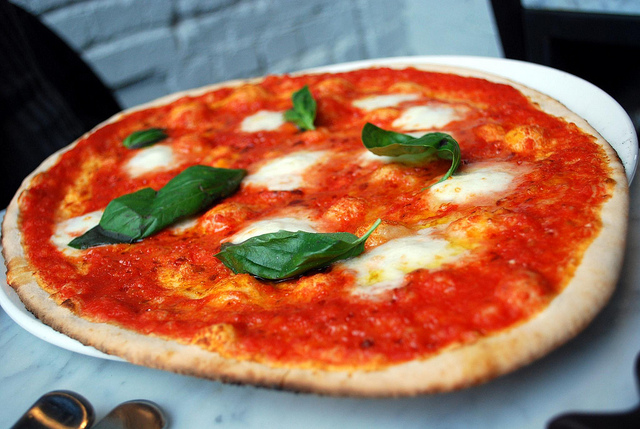
Image source: Flickr user Alpha
4) Buffalo mozzarella: Made from the milk of a water buffalo, which has considerably more fat than cow’s milk, this cheese is incredibly creamy and rich. Thick, round slices of buffalo mozzarella will melt across your artisan pizza, and you’ll be a convert in no time.
5) Quail eggs: It may sound strange, but small quail eggs (less than a quarter of the size of chicken eggs) cracked over a piping-hot pizza will cook just enough so that the outside will set, providing you with a deliciously runny egg yolk when you poke it with your fork. The same effect can be achieved with a chicken egg, but it’s not as cute (and the smaller size of quail eggs makes them a little sturdier, which is handy when trying to survive the food delivery trek).
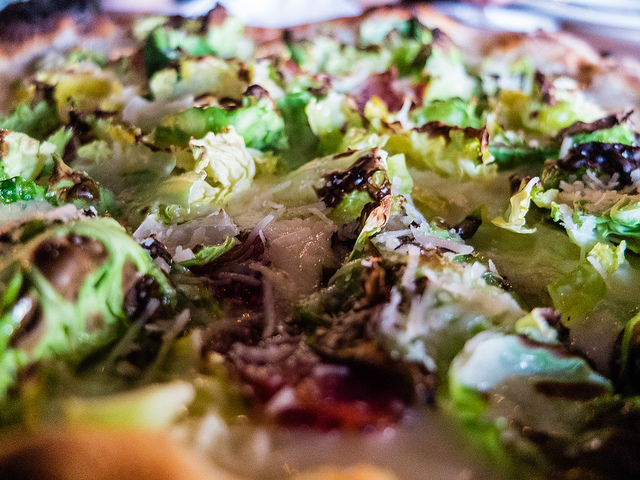
Image source: Flickr user Roland Tanglao
6) Brussels sprouts: Even if you think you don’t like Brussels sprouts, this unique topping is worth a try. Oven-roasted to bring out their best flavor (and remove the bitterness that can plague undercooked Brussels sprouts) they’re especially tasty on white-sauce pies, or when paired with a rich cheese and wild mushrooms.
7) Honey: Yes, honey on pizza is a thing now. Salty and sweet are a classic combination, and when honey is drizzled over a cooked pizza, it adds a subtle contrast to spicy, salty meats (like soppressata).
Liven up the classic food delivery order and try an artisan pizza at your next Friday lunch (or even a late-night hackathon). With plentiful menus and easy online ordering, it’s easy to have your dream pie delivered right to your office from Waiter.com!
Now that Wal-Mart Is Going Organic… What About Your Corporate Catering?
By now, you’ve likely heard the big news that Wal-Mart is investing in organic foods. And while the knee-jerk reaction in the media may have been a collectively raised eyebrow, the truth is, Wal-Mart’s move says a lot more about American culture than it does about Wal-Mart’s… and as an employer, it’s worth considering how your own workplace culture fits into the picture, particularly when it comes to your corporate catering and organics.
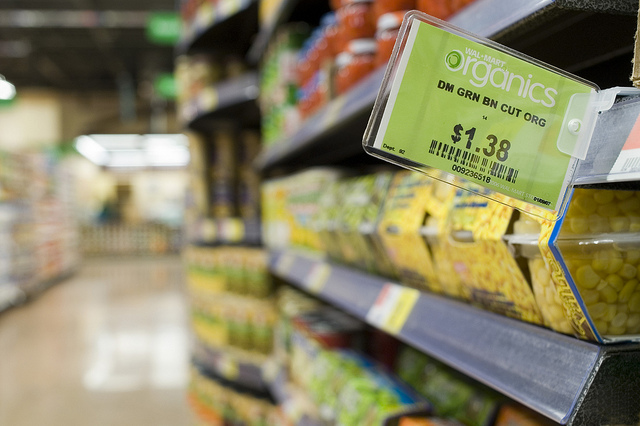
Image source: Flickr user Walmart Corporate
Consider this: Wal-Mart’s partnership with Wild Oats, and their intention behind expanding their existing organic grocery business (permitting customers to buy organic food at non-organic prices) signals that not only is the organic food game about to change, but that the world’s largest retailer considers it a game worth playing. Organics aren’t a niche market anymore; Wal-Mart’s research shows that 91 percent of its shoppers would like to buy affordable organic food products. So Wal-Mart will do what it does best: give their customers what they want, at cheaper prices than their competitors, because they can make production less expensive and more efficient thanks to the economy of scale.
This is where your office’s corporate catering comes in. If your company hasn’t jumped on the organic food bandwagon when it comes to the office meals and business lunches you feed your staff, this Wal-Mart news should be a wake-up call: it’s not really a bandwagon anymore. If Wal-Mart customers are clamoring for organics, chances are good your staff wants to eat organic as well.

Image source: Flickr user Britt-knee
Of course, you have a bottom line to consider, too. And organic corporate catering is usually more expensive than non-organics (at least for now — some experts are predicting, however, that Wal-Mart may shift the entire landscape of organics). So even if your employees would like to eat organic at the office, is organic catering worth the increase in cost?
Scientifically, maybe. There’s little doubt that eating organic means we consume far fewer residual pesticides, but some questions remain about whether the levels we do consume with conventional foods even make a difference — and those levels vary widely depending on whether you’re talking about organic produce, meat, or dairy. The debate about organic vs. conventional in the scientific community is often heated, and rarely results in clear answers.
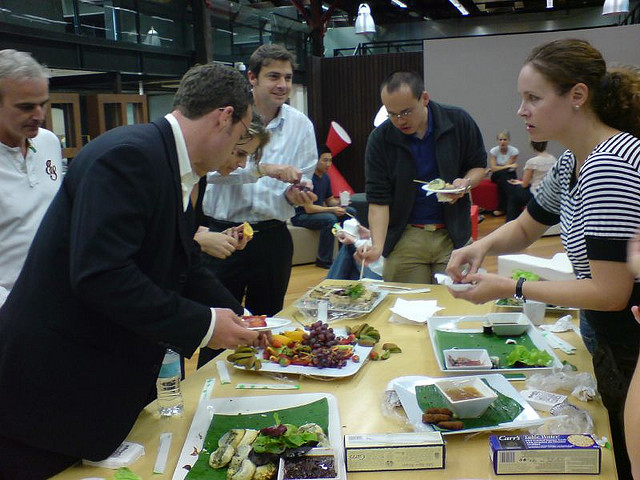
Image source: Flickr user Alana
But a lot of people, likely including your employees, want to eat organic anyway. We want to eat less pesticide-tinged produce, we want our dairy to come from cows that haven’t been pumped full of growth hormones, and we want the animals whose meat we consume to have had a better life. And the current perception is that organic can give us what we want.
In many ways, as an employer, the people who work for you are your customers. It’s part of your job to make them feel appreciated and to keep them engaged. After all, employees who feel appreciated and engaged will work harder, be more loyal, and simply perform at a higher level than those who don’t.
If your employees do place a premium on organic food, then it might be wise to take a page from Wal-Mart: give them what they want. Organic corporate catering could be a valuable way to communicate your appreciation and boost their engagement. The cost may be a little higher, but after all, employee satisfaction is one of the best investments you can make.
You’ll find the perfect corporate catering solution for your workplace at Waiter.com — and a diverse line-up of menus to ensure everyone in the office leaves the lunch table feeling happy, well-fed, and utterly appreciated!
5 Ways to Feature the Mediterranean Diet in Your Corporate Catering Routine
The Mediterranean diet is in the news all the time — only, unlike some of the other recent diet fads, it’s not due to celebrity endorsements or splashy self-help books. Rather, the Mediterranean diet tends to crop up in news articles and NPR broadcasts because scientists and researchers are continually finding new health benefits to its core tenets: eating plenty of vegetables, fruits, nuts, fish, and olive oil, along with less meat, butter, and processed foods.
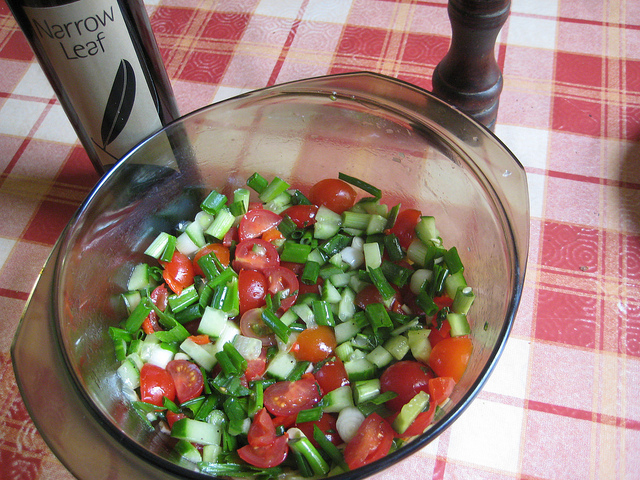
Image source: flickr user AndyRobertsPhotos
For instance, last November, we learned that women who generally followed a Mediterranean diet in their fifties were 40 percent less likely to develop chronic diseases, like Parkinson’s and cancer, later in life, and had better memory and physical function than women who didn’t eat as healthfully. So far this month, two different reports show that following the Mediterranean diet can lead to reduced risk of plaque buildup in our arteries and even reduce our risk for Type 2 diabetes.
It’s becoming increasingly apparent that the Mediterranean diet may be a very smart strategy to counter the ongoing obesity crisis and skyrocketing occurrence of chronic diseases that are driving health care costs out of control. Employers who are seeking ways to promote employee health and wellness — and reducing their own health care costs at the same time — would be smart to consider how they can promote a Mediterranean diet within the walls of the workplace. And since it’s hard to encourage employees to eat more fresh vegetables and fish while simultaneously stocking the vending machine with Cheetos and ordering double-pepperoni pies every Friday, here are a few ways to feature the Mediterranean diet in your corporate catering routine:
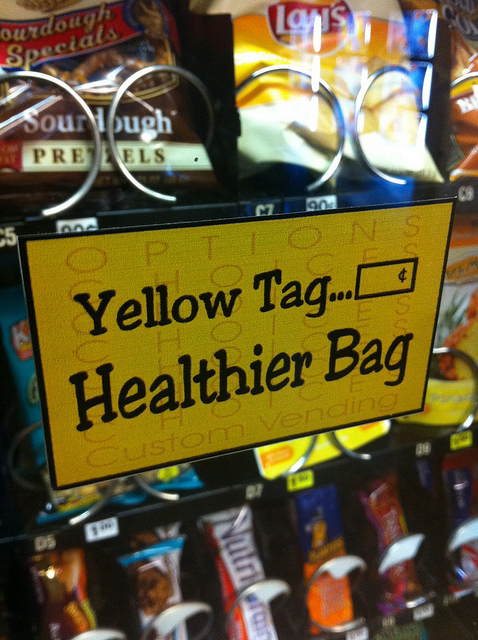
Image source: flickr user JasonTester
Office vending machines and snack drawers are notoriously stuffed with potato chips, packaged cupcakes, and all of the highly processed junk foods that nutrition experts advise we should rarely, if ever, eat… and certainly not try to make a meal out of during busy workdays when we need sustainable, wholesome energy the most. When it comes to easy-to-access snack foods, take a cue from the Mediterranean diet and supply packages of lightly salted nuts, fresh or dried fruit, and whole grain crackers.
If you occasionally order in lunch for your staff as a special thank-you or celebration, don’t simply default to pizza delivery or greasy takeout boxes. Consider healthier takeout options like sushi, which is a great source of fresh fish and can be made with fiber-rich brown rice, or Indian cuisine, which is usually based around vegetables, lentils, and chickpeas instead of meat and white bread.
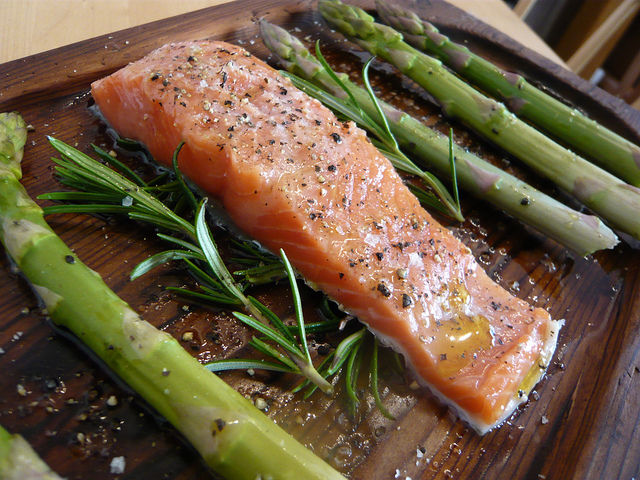
Image source: flickr user WordRidden
Treating your staff to fully catered meals is an excellent way to introduce Mediterranean diet-friendly foods into the office. Just choose salmon instead of beef or pork for an entree dish, and swap out the mac and cheese or mayo-heavy pasta salad in favor of a whole grain version, like tabbouleh or a quinoa salad. Be sure to include a few vegetable side dishes, like asparagus drizzled with olive oil or roasted root vegetables. Potatoes, America’s favorite vegetable, aren’t really included in the Mediterranean diet.
Most importantly, don’t just start serving different, healthier foods without telling your employees why! Make the Mediterranean diet’s potential an ongoing conversation, and create a positive environment that supports healthy lifestyle changes. Schedule a chef to come in and conduct a healthy cooking class one afternoon, or have a nutritionist present at a lunch-and-learn. And when it’s time to order office meals, Waiter.com can help your office break out of unhealthy eating habits by presenting a wide variety of wholesome, Mediterranean-friendly meals.
Looking for Healthy Lunch Ideas? Consider the Criteria of the DASH Diet
Never heard of the DASH diet? Congratulations — that probably means you don’t have to worry about your blood pressure. However, if you’re trying to start the new year off right when it comes to your eating habits, you may want to take note. The DASH diet has been ranked by U.S. News & World Report as the top overall diet for three years running, thanks to its flexible meal options and emphasis on heart-healthy foods like whole grains, vegetables, and moderate amounts of lean meats. While its main goal is to help stave off hypertension, don’t think of it as an old-person diet: studies have found that following the DASH diet’s high-fiber, moderate-fat, veggie-centric recommendations can also naturally lead to weight loss — even in teenage girls.
Want to take a cue from the DASH diet when it comes to your own eating habits? Here are a few of the primary guidelines of the award-winning diet, along with a few healthy lunch ideas plucked right from the eating plan’s official recommendations (one added bonus: since the DASH diet was primarily developed by the National Heart, Lung, and Blood Institute, the reading materials and recipes are free to access).

Image source: flickr user Dalboz17
1) Eat lean meats, in moderation
The DASH diet recommends limiting your meat consumption to lean meats and cancer-fighting fish, and eating no more than 6 ounces per day. Just for reference, Chipotle scoops four ounces of chicken onto your burrito bowl or salad — there goes 2/3 of the daily allowance before you’ve even thought about dinner. Ask for extra black beans and half the chicken, along with brown rice and fajita veggies for a DASH-inspired Mexican lunch, or go for a veggie-heavy stir fry with a small portion of meat at the Chinese restaurant.
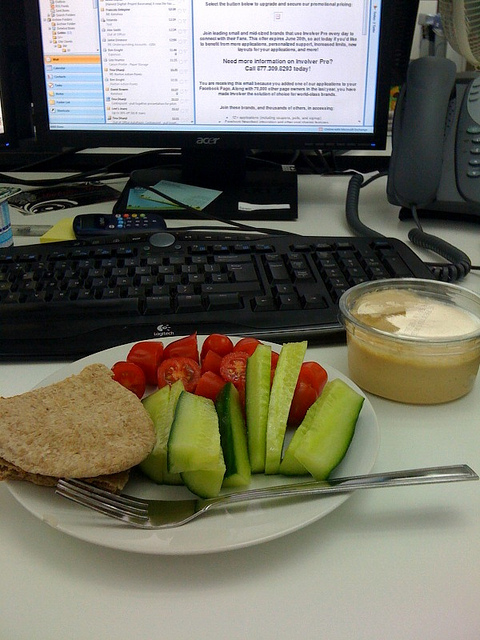
Image source: flickr user gemb1
2) Eat LOTS of fruits and vegetables, but start gradually
The DASH recommendations call for 4-5 servings of veggies and fruits per day — each! That’s a lot of produce. If you aren’t already eating a lot of fruits and veggies, a sudden increase can upset your digestive system. The DASH diet suggests adding a serving each at breakfast and lunch for a few days, so you can gradually work your way up to the recommended amount. Start with some easy substitutions — instead of grabbing a bag of chips at lunch, order a side salad with low-fat dressing or opt for a cup of raw veggies and hummus. Make it a point to branch out and try new fruits and veggies: pick up a few apricots instead of a banana for a snack, or dip slices of red bell peppers instead of cucumbers. That’s the beauty of DASH — there’s plenty of room for a wide variety of food.
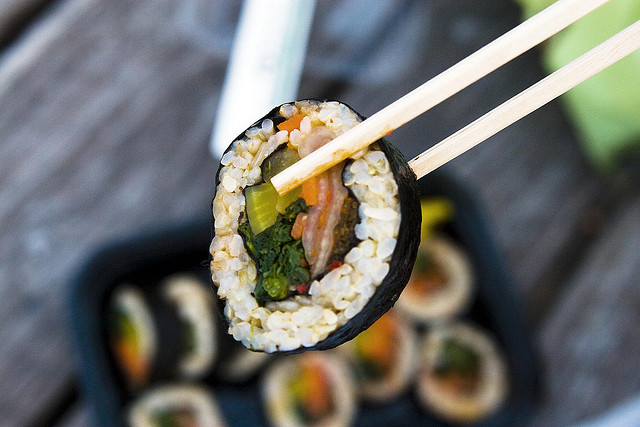
Image source: flickr user Pabo76
3) Carbs are allowed, but whole grains are key
DASH recommends your daily calories come from a certain ratio of foods: 27% from fat, 6% from saturated fat, 18% from protein, and 55% from carbohydrates. Don’t think this means that half your lunch plate should be filled with soft pretzels or rolls, though: DASH suggests choosing whole grains whenever possible, and eating plenty of legumes (that is, beans). At lunch, that may mean picking brown rice instead of white in your sushi roll, swapping whole-wheat bread for ciabatta on your deli sandwich, or requesting a whole-grain salad like tabbouleh instead of mac and cheese at a catered office meal.
There are several other components to DASH, like sodium intake and cutting back on sugary foods, but these three simple rules of thumb can help guide you to find the healthy lunch ideas that will start your new year off right. Sticking to a diet at the office can be tricky, but with the wide range of catering options available from Waiter.com, it becomes much easier to make smart choices and eat the kind of delicious and wholesome foods that the country’s top-ranked diet recommends.
From Corporate Catering to Wellness: What America’s Happiest Companies Have in Common
The newly crowned happiest companies in America (according to rankings from CareerBliss.com) include a pharmaceutical giant, a health insurer, and whatever exactly GE is these days. What do they have in common? These companies understand key factors to employee happiness, like work-life balance, relationships between coworkers, growth opportunities, and work environment.
One other thing? With few exceptions, they all have really stellar workplace wellness programs and healthy corporate catering plans.

Pfizer, the pharmaceutical company that claimed the top ranking for employee happiness, emphasizes on-site fitness centers, smoking cessation programs, and healthy cafeteria offerings as part of its “Healthy Pfizer” program. At Kaiser Permanente, the insurer who took #2, the companywide employee wellness program is centered around healthy choices: from stocking healthy food in vending machines to offering yoga classes on their campuses. GE even created an internal certification program for its numerous work campuses to be officially recognized as “HealthAhead” sites. With 50 measures ranging from smoke-free workplaces to nutritional labeling in cafeterias, GE places a huge emphasis on the personal choices employees can make to improve their overall health.
Google, at #21 on the happiness index, is famous for its food philosophy: providing free, high-quality meals at restaurants and cafes throughout its campus. And when faced with the recent discovery that workers were probably overindulging on M&Ms, Google put behavioral psychology to the test. They moved the complimentary candy to opaque bowls, while stocking healthy treats like pistachios and dried figs in glass jars… and candy consumption fell dramatically. That kind of concentrated effort goes far beyond simply providing a company gym and catering healthy meals; Google, like Pfizer, Kaiser, and GE, is truly proactive about looking out for employee health.

Of course, the yoga classes and free pistachios aren’t just about keeping employees chipper and cheerful. The highly analytic and successful minds behind these companies know that happy, healthy employees miss fewer days of work and rack up significantly lower health care costs. But for employees, the end result is the same: a better environment where they can spend their days and an employer that is committed to their long-term wellbeing.
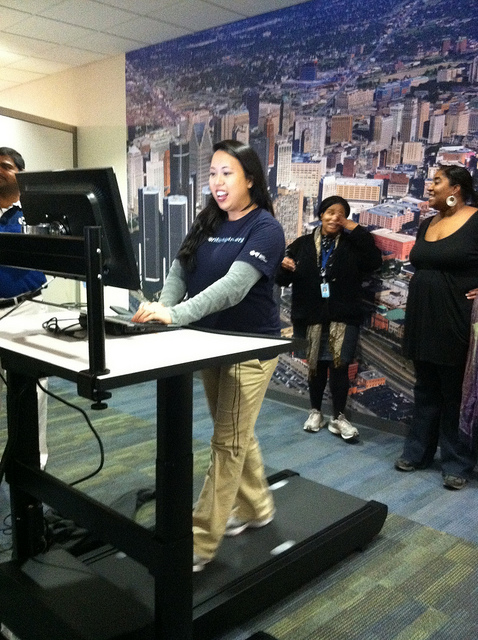
But what if you don’t have the budget of a multinational pharmaceutical firm? That’s where Greatist.com’s list of the 46 healthiest companies to work for comes in handy. Their “Tiny Business” category includes only companies with less than 100 employees. The top-ranked little guys include a Tampa law firm, a blogging platform, and a Milwaukee-based sports marketing company — a far cry from mega-corporations like GE and Pfizer. They may be smaller, but these companies operate under the same philosophy as the big guys: workplace wellness is worth the investment. OK, so providing free company lunches on Fridays, a regular fresh fruit delivery, or a handful of on-site bicycles for employee use may be a smaller investment, but the impact can be just as large.
Healthy, happy workers are key to a successful workplace, and there are solutions out there for companies of all sizes and industries. Whether this means healthy snacks in the breakroom, weekly office breakfasts, or full catered healthy lunches, Waiter.com can help your office find its ideal path to workplace wellness!
The 6 Biggest Food Trends of 2014 That Will Change Your Corporate Catering Routine
If 2013 was the year of the cronut, then 2014 may be the year of the… bean?
Food writers, chefs, and consumer research firms are coming forth with their annual predictions for the next year’s food trends. Most trends have one thing in common: Americans are more concerned than ever about eating healthier foods, and restaurants and grocers are adjusting their offerings accordingly. For office managers and administrative staff who are placed in charge of corporate catering and keeping the workplace happy and well-fed, here are the top six food trends that may influence your company’s food programs in the coming year:
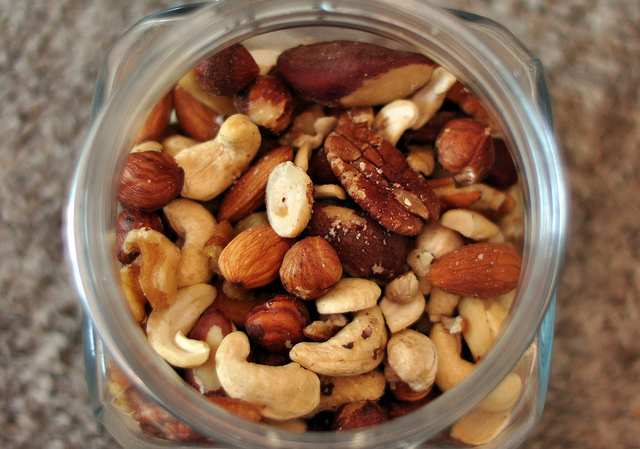
Image source: flickr user TheTravellingBum
1) Healthy snacks. Consumer research shows that Americans are snacking more than ever, but are trying to choose healthier options like nuts and fruit versus chips and candy. This is one food trend that is well worth following in the office: stocking healthy snacks in the break room helps keep workers energized throughout the day, and brain-boosting foods can help sharpen focus and attention.
2) Where’s the beef? If your office’s corporate catering plan currently includes lots of beef-heavy dishes, a change may be in store. The NPD Group, a market research firm based in New York, advises that rising beef and falling chicken prices will likely lead many restaurants to adjust their menus. To manage food budgets and increasing demand for leaner proteins, this may mean swapping in chicken fried rice for beef and broccoli when it’s time for a Chinese lunch delivery.
3) Gluten-free menu options. The NPD Group also reports that consumer demand for gluten-free options are rising — not necessarily due to allergies, but to an overall increase in healthy eating. Especially when trying to meet the needs of a large group order, this trend will certainly make life easier for corporate catering organizers!
4) Mobile apps. This may seem only tangentially related to food trends, but considering the trend towards health-conscious eating, it makes sense: more companies will use mobile technology to connect with their customers, such as allowing smartphone users to scan a product’s label and access detailed nutrition and ingredient information.

Image source: flickr user IndianaPublicMedia
5) Cauliflower. Look out kale: chefs and researchers alike predict that cauliflower will be the new year’s trendiest vegetable. Cauliflower is surprisingly versatile, full of nutrients, and can even be used to make healthier versions of carb-heavy dishes like mashed potatoes and rice. As cauliflower begins to become prevalent on restaurant menus, expect your coworkers and employees to clamor for cauliflower in the catering order.

Image source: flickr user tonrulkens
6) Beans. CNN’s food editors and highly respected Washington, D.C.-based chef Jose Andres agree: beans are on the upswing. As vegetarian diets and health-driven concepts like Meatless Mondays become more common across the country, unusual and heirloom varieties of beans will be a popular alternative to traditional meat-and-poultry proteins. Office meals should always accommodate vegetarian needs, but as beans are treated as a centerpiece by respected chefs, entrees starring the fiber-rich protein source may become a widely requested staple of your corporate catering routine.
When it comes to staying atop the latest food trends and growing demands for a wider variety of healthy meals, Waiter.com is here to help. Easy online ordering and Virtual Cafeteria Service streamlines corporate catering and makes providing the highest-quality office meals your employees deserve a breeze.
